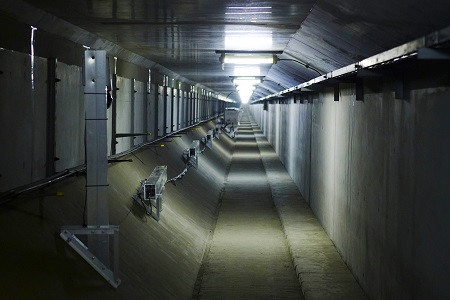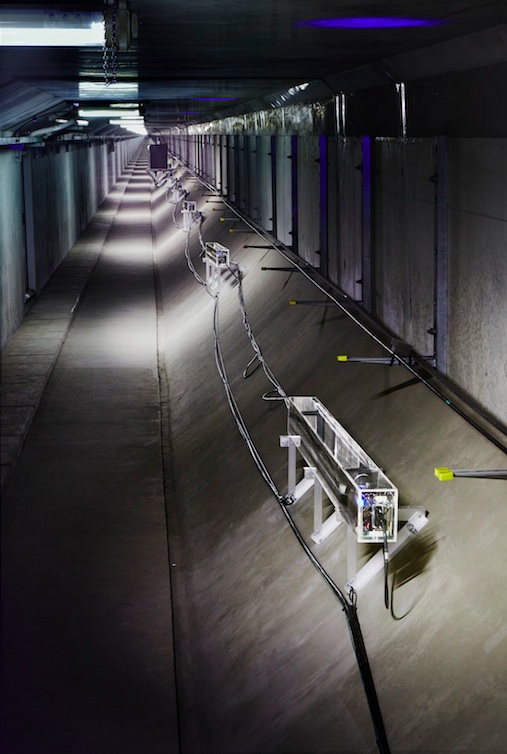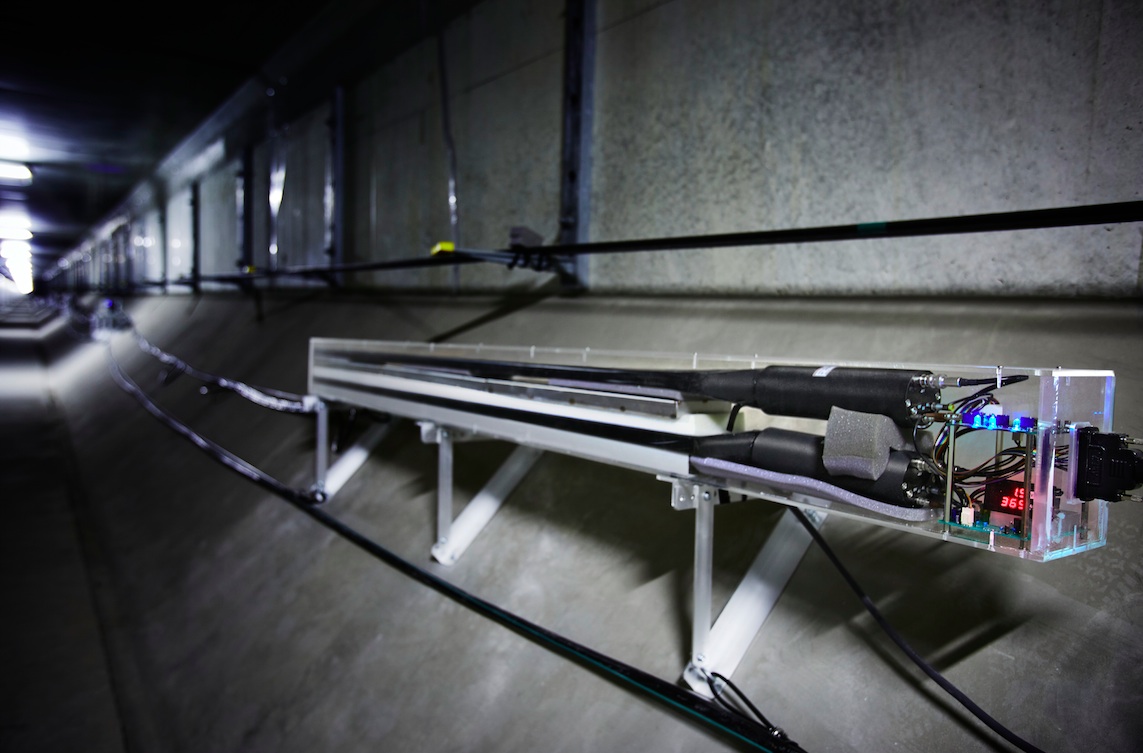Cosmic rays reveal tsunamis and waves Undersea sensors to detect tidal phenomena are the first of their kind


Aqua-Line service tunnels. By the end of 2021, this tunnel should house over 100 muon detectors stretching along a 1-kilometer section, around 45 meters below sea level. © 2021 Hiroyuki Tanaka/Muographix
The first trial of an undersea sensor array to detect rapidly changing tidal conditions in Tokyo Bay has been a success. The Tokyo-bay Seafloor Hyper KiloMetric Submarine Deep Detector (TS-HKMSDD) uses particles generated by cosmic rays called muons to visualize variations in depth and density of the sea and seafloor above it. When this array is expanded, it should provide sufficient resolution to monitor the area for potentially dangerous natural disasters and aid the search for natural resources such as gas deposits.
The Tokyo Bay Aqua-Line is a roadway that connects Haneda Airport with Chiba Prefecture to the east. Its longest section is a 9.6-kilometer-long tunnel that extends 45 meters below sea level. This tunnel is primarily used for road traffic, but has now also become home to a unique scientific endeavor. It now houses around 10 special muon detectors within its service tunnels to the side of the road tunnels. This may seem like a strange place for such things as they cannot possibly see the sky. But this is because what they do see is no ordinary kind of light.
The detectors see muons. These particles are created in the atmosphere and pass through ordinary matter with ease. They are only slightly affected by the amount and density of matter they pass through, but the slight variations that result from this can be picked up by these highly specialized detectors. Similar in principle to the way an X-ray machine images bones inside a human body, the signals from multiple detectors can be combined to form a crude image of the distribution and density of matter, based on the number and positions of muons detected. These images can be put to different uses.
“Our successful first trial shows that we can image the sea above the tunnel with a spatial resolution of 10 meters and a time resolution of one minute,” said Professor Hiroyuki Tanaka from Muographix at the University of Tokyo. “This clarity of data means we could use the detector to sense dangerous sea conditions such as strong storm waves or even tsunamis. And as muons come from all directions, it’s possible to build images of the seafloor itself. This could be useful in detecting the natural gas reserves believed to exist there.”
The TS-HKMSDD will commence full-time operation on May 5, 2021. The modular nature of the detector installation means that new sensors can be added continuously, improving the capabilities of the array as they go. Tanaka and his team aim to run a line of about 5,000 sensors along the nearly 10-kilometer tunnel. This configuration would make it the longest particle detector of its kind. The success of this trial could also help the project expand to other locations worldwide including the North Sea around the British Isles.

Muon detector. Each of these detectors is about two meters long. If the complete set of around 5,000 modules is constructed, it will stretch along the full length of the tunnel. © Hiroyuki Tanaka/Muographix
Partnership information
The Tokyo-bay Seafloor Hyper KiloMetric Submarine Deep Detector (TS-HKMSDD) is a multiaspect muographic apparatus that allows us to tackle multiple marine science and engineering themes, and is jointly used by researchers and engineers from different fields in different departments of UTokyo: International Muography Research Organization (Muographix), Atmosphere and Ocean Research Institute (AORI), Institute of Industrial Science (IIS) and the Graduate School of Frontier Sciences. Besides UTokyo, several international institutions, including the Wigner Research Centre for Physics in Hungary; the University of Sheffield, Durham University, Boulby Underground Laboratory, UK, the University of Catania, National Institute of Nuclear Physics, National Institute of Astrophysics and National Institute of Volcanology and Geophysics in Italy; and the University of Atacama in Chile, along with academic (including Kyushu University and Kansai University) and private sector collaborators (including NEC) will contribute to TS-HKMSDD projects.






